Cichlid fishes native to South America are not aggressive. They are friendlier than the cichlids that are native to Central America and Africa. Because of the docile character of these fish, they’re a suitable choice for community aquariums.
So, what’s the catch?
Approximately 450 different species of cichlid fish may be found in the seas surrounding South America. Depending on where they are found, these cichlids have distinct preferences for the murky streams of the Amazon, the gloomy forests of Peru, or the wide waters of Colombia and Venezuela.
Contents
What you need to know
Before listing the best South American Cichlids Tank Mates, a word of caution.
It is never possible to objectively determine which fish would make the “perfect” companions for your cichlid. It is dependent on factors such as the size of the tank, the nutrition of the fish, the time of year, the availability of hiding places, and the disposition of the fish.
Temperament
South American cichlids prefer to inhabit softer, more acidic environments with a pH between 6.5 and 7.4. Depending on location, the water temperature varies from the mid-60s to far beyond 84 degrees Fahrenheit; however, the optimal temperature for the majority of species is between 75 and 80 degrees Fahrenheit.
Size
The smallest South American cichlid species is barely 3 centimeters long, while the biggest may reach 60 centimeters in length. The freshwater angelfish is the most well-known South American cichlid.
Competition
Combining species that coexist naturally in the wild, the majority of which are medium to big in size is a good idea . You could combine severums, Satanoperca, chocolate cichlids, angelfish, Uaru, and even wild Discus if the aquarium was at least 1.8 meters (6 feet) in length.
Parameters ; Tank Setup
Decorate with vegetation, stones, and fish. Due to the territorial nature of cichlids, ensure there is sufficient furniture for each fish to have its own territory. Cichlids love concealment, therefore a few cave formations were added to the aquarium. Before adding anything to the tank, ensure that it is clean.
15 Best South American Cichlids Tank Mates
More similar posts you don’t want to miss:
1. Silver dollar fish
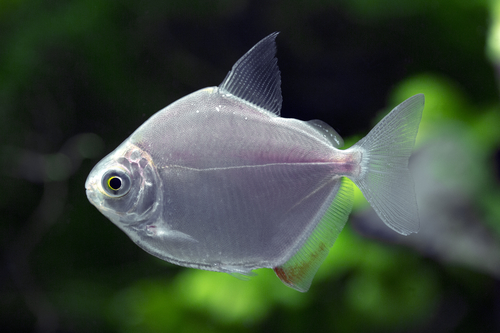
- Scientific Name: Serrasalmidae
- Adult Size: 6 inches
- Water Temperature: 75 to 82 F (24 to 28 C)
- Minimum tank size: 100 gallons (378 liters)
- Care Level: Intermediate
Don’t judge a book by its cover. The silver dollar fish is the least aggressive species of freshwater fish that we have access to. In the event that the circumstances of the tank are not fully satisfied, they have the potential to become semi-aggressive; nonetheless, in most cases, they are fairly docile.
Despite their small size, they are robust enough to tolerate the presence of bigger cichlids, silver dollar fish are able to dwell happily with South American cichlids of varying sizes. Try putting them with acaras, juruparis, festivums, or oscars.
2. Clown loach

- Scientific Name: Chromobotia macracanthus
- Adult Size: 20–30 cm
- Water Temperature: 70s to low 80s Fahrenheit
- Minimum tank size: 75-gallon
- Care Level: Simple
Loaches, sometimes known as clown loaches, are docile fish that like to stay around the tank’s base or in the center of the water column. As a result, unexpected encounters with other cichlids as well as territorial violence may be avoided for the most part.
In addition, even when confronted on occasion, they are often able to effortlessly maintain their composure and stand their position. Because of this, you’ll often see them in community aquariums.
They are also quite good at disguising their whereabouts. Therefore, don’t forget to provide a number of concealing places inside the tank.
3. Corydoras Catfish
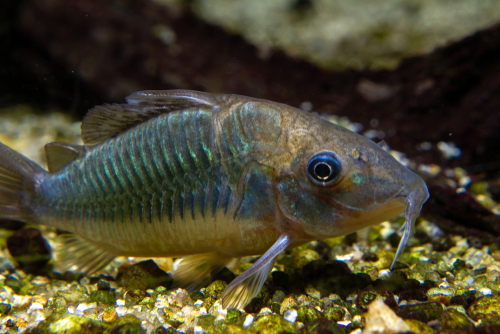
- Scientific Name: Corydoras
- Adult Size: 2 to 3 inches
- Water Temperature: 72 and 82°F
- Minimum tank size: 10-gallon
- Care Level: Easy
The corydoras may be great tank mates for the smaller and medium cichlids. They have a well-deserved reputation for having a demeanor that is tranquil, quiet, and completely lacking in aggression. They like solitude and a deliberate approach to scavenging.
Due to their position at the aquarium’s bottom, cichlids will never come into contact with these fish and hence have no reason to become territorial.
In general, cory fish are nocturnal, however there have been reports of them sitting still for hours at a time.
Due to their little stature, corydoras are more likely to thrive in a large group setting. This means you should probably only add a few at a time.
4. Leopard bush fish
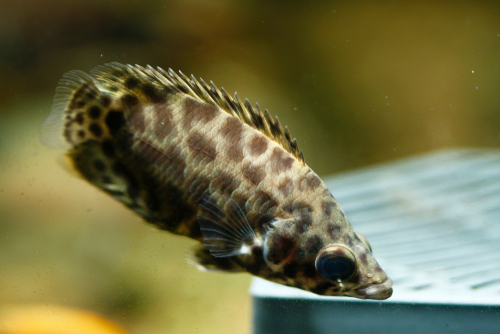
- Scientific Name: Ctenopoma acutirostre
- Adult Size: 20 cm (8 in)
- Water Temperature: 73 – 82 F.
- Minimum tank size: 108 litres
- Care Level: Intermediate
The leopard bush fish, which also lives at the bottom of the list, has a reputation for being a quiet and placid creature. They are so reticent that you may even call them shy; you can often find them lurking and foraging in the dense undergrowth at the bottom.
The fact that they do not come to the surface eliminates the possibility of a territorial conflict with cichlids. Bear in mind, though, that leopard bush fish do have a tendency to claim their territory. Therefore, you should make sure to incorporate caverns and places to hide.
5. Otocinclus

- Scientific Name: Otocinclus
- Adult Size: 1 1/2 – 2 inches
- Water Temperature: 72-82°F
- Minimum tank size: 55 gallons
- Care Level: Easy
Because of their tiny size, otocinclus should only be kept with other cichlids that are of a similar size or smaller. These fish like to avoid conflict and often keep to themselves. In addition to this, they are rather nervous. When they sense danger, they are able to sprint across the tank at a blazing pace.
These fish have a strong sense for survival, which is helped by the fact that they are incredibly nimble. However, you shouldn’t keep them alongside cichlids that are medium or large in size.
Due to the fact that they eat on the sediment, cichlids will seldom come into contact with them.
If you want to keep otocinclus in the tank, you will need to provide them with a number of places to hide so that they do not get exposed.
6. Dwarf gourami

- Scientific Name: Trichogaster lalius
- Adult Size: Six to seven inches in length
- Water Temperature: 70–85 °F
- Minimum tank size: 30 gallons
- Care Level: Moderate
When housed in a community aquarium, dwarf gouramis thrive because of their versatility and reputation for peace and quiet. It’s common to observe a paired fish swimming together.
While the vast majority of South American cichlids should be “tolerable” tank mates, there are a few that might be harmful. But when your dwarf cichlids are transferred to a new habitat, they may be more secretive than normal at first.
7. Pearl gourami
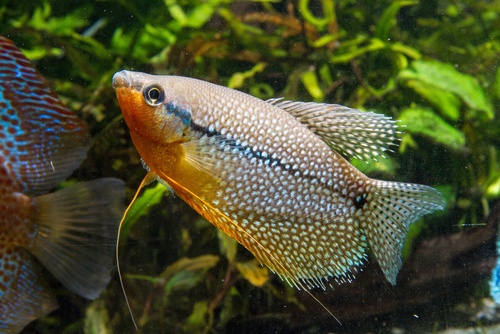
- Scientific Name: Trichopodus leerii
- Adult Size: 12 centimetres (4.7 in)
- Water Temperature: 72–86 °F
- Minimum tank size: 20 gallons
- Care Level: Easy
While their vibrant colors certainly draw attention, the calm nature of pearl gouramis is what makes them so popular. These fish tend to be peaceful in schools and may live peacefully with a broad range of other fish species.
Only during mating season do we see their true ferocity, as the males compete fiercely for the attention of the ladies.
8. Keyhole cichlids

- Scientific Name: Cleithracara maronii
- Adult Size: 4.75 inches
- Water Temperature: 72 to 79 degrees Fahrenheit (22 to 26 degrees C
- Minimum tank size: 20 gallons
- Care Level: Easy
Keyhole cichlids are the least aggressive cichlids. These cautious fish hide most of the time. Keyhole cichlids are a good choice if you have electric yellow labs and want calm, even-tempered cichlids.
They’re just 4 to 5 inches long. This fish will depart the situation if it smells enmity.
They prefer swimming among the aquarium’s plants and decorations. They don’t dig burrows or harm plants.
Only during reproduction will they act violently, and even then, it’s little compared to other cichlids.
9. Zebra cichlids
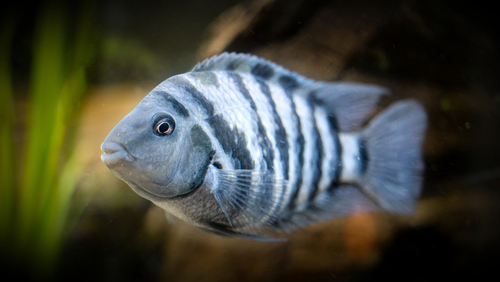
- Scientific Name: Amatitlania nigrofasciata
- Adult Size: 11.3 cm (4.4 in)
- Water Temperature: 76°F – 82°
- Minimum tank size: 55 gallons
- Care Level: Intermediate
Zebra cichlids rival yellow labs in popularity. In aquariums, they frequently coexist peacefully. Cichlids do best when kept among their own species.
I’ve never combined the two. Several people on fish message boards advised zebra cichlids as tankmates for yellow labs. Their names are listed.
Zebra cichlids are more forceful than others. Your yellow labs will be the first to surrender in a hostile situation.
10. Dragonblood peacock cichlids
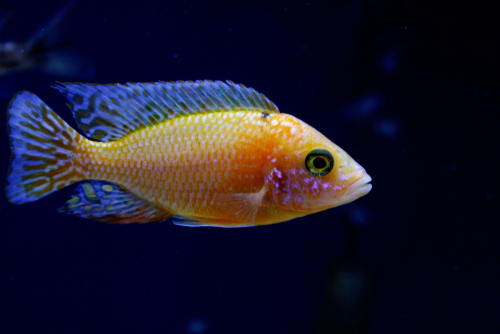
- Scientific Name: Andinoacara pulcher
- Adult Size: Six to seven inches in length
- Water Temperature: 72–86 °F
- Minimum tank size: 30 gallons
- Care Level: Moderate
Dragonblood peacock cichlid is another internet forum proposal (only males). These cichlids’ names match their interest. This isn’t typical.
Dragonblood peacock cichlids are the result of decades of selective breeding of Lake Malawi peacocks. As their name indicates, they are reddish-orange. One catch: Unfortunately, only men have this beautiful characteristic.
Yellow and red compliment each other wonderfully, which is why these fish got so many votes. However, proceed with care.
Males of this type are reportedly quite antagonistic. The tank should have ample area, plenty of food, and places to hide.
11. Blue Acara
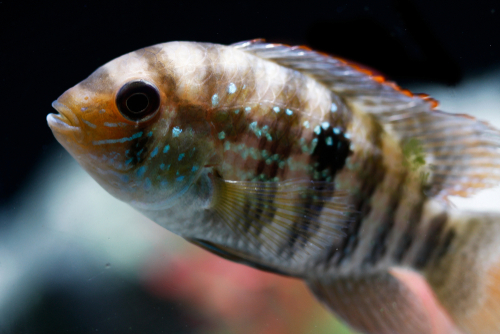
- Scientific Name: Andinoacara pulcher
- Adult Size: Six to seven inches in length
- Water Temperature: 72–86 °F
- Minimum tank size: 30 to 40 gallons
- Care Level: Moderate
Blue Acara cichlids are another peaceful species that thrives in community tanks. These fish, unlike other cichlids, are independent and laid-back.
Territorial or resource disputes will be rare. They like to dig close to the dirt.
Electric yellow cichlids shouldn’t be aggressive with smaller fish despite their reputation.
12. Giant Danios

- Scientific Name: Devario aequipinnatus
- Adult Size: 4 inches
- Water Temperature: 72 to 75 F (22 to 24 C)
- Minimum tank size: 30 gallons
- Care Level: Easy
Giant Danios concentrate in the middle and lower levels of their habitat, they are a good addition to your electric yellow cichlid community. Get larger danios so your cichlid won’t find them tasty.
These fish have quick reactions. In a fight, they may swim away and hide.
13. Pleco
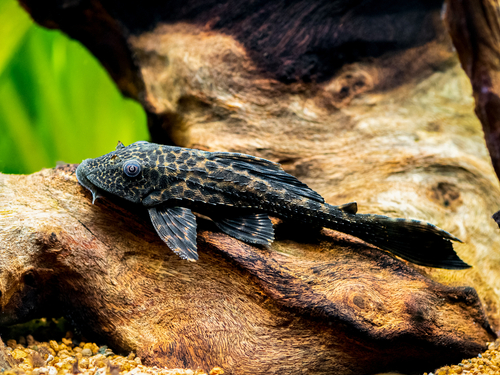
- Scientific Name: Hypostomus plecostomus
- Adult Size: 50 centimetres (20 in)
- Water Temperature: between 74° and 80°
- Minimum tank size: 75 gallons
- Care Level: Easy
Plecos are low-maintenance, quiet, and clean the tank. Bottom-dwellers eat algae and debris in tanks, keeping water cleaner for longer.
They don’t move from the tank’s bottom, so they won’t hurt your electric yellow cichlids.
Due to separate travel and foraging regions, territorial aggression is unlikely.
Plecos are naturally friendly. Despite occasionally attacking their own species for food and mates, they seldom attack fish.
14. Upside down Catfish
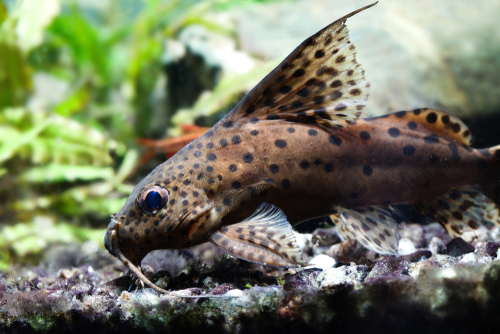
- Scientific Name: Synodontis nigriventris
- Adult Size: 3.5 to 4 inches
- Water Temperature: 70 – 82F (21 – 28C)
- Minimum tank size: 55 gallons
- Care Level: Easy
According to its name, the upside-down catfish swims with its head down. They’re also one among their genus’ least aggressive individuals. They may be used in most community aquariums, providing the fish isn’t aggressive.
These catfish, like others, prefer to sleep during the day and hunt at night. Therefore, territorial conflict with electric yellow cichlids is unlikely.
Since both species appreciate hiding (at different times), your aquarium must include a variety of hiding spots.
These fish may reach 25 cm (10 inches). Keeping them requires a large tank.
15. Convict Cichlids

- Scientific Name: Amatitlania nigrofasciata
- Adult Size: 4-5 inches
- Water Temperature: 70 – 82F (21 – 28C)
- Minimum tank size: 20 gallon (75 litre) tank
- Care Level: Easy
Convict cichlids get their name from their black-and-white stripes. These cichlids are among the most aggressive available. The threat is real.
Convict cichlids are recognized for their violent nature and unique look. Although these traits are common in cichlids, a prisoner’s thinking is unique.
Convict cichlids will murder other fish to defend their area. Guards will follow and torture the intruder.
Convict cichlids are territorial and mark and protect their territory.
You must grasp their aggressive and territorial traits to match them with red demons. You must make the tank big and supply enough decorations for everyone.
Convict cichlids are less territorial in large tanks with plenty of hiding spots. I’ve personally witnessed this.
Conclusion
Our list of South American cichlid-friendly fish is complete. There’s no guarantee your fish will like the new addition.
The optimal tankmates for your South American cichlids depend on tank size, layout, fish size, temperament, and water chemistry.
Frequently Asked Questions
South American cichlids in my aquarium?
Mixing medium- to large-sized species that cohabit in the wild may swiftly achieve this aim. Acarichthys heckelii and Biotodoma Cupido are pleasant friends.
Can I smother them like Malawians?
It’s not how fish like to live, and even if it were feasible, they wouldn’t want to. Instead of looking majestic with long, flowing fins and tails, they’d end up looking dog-eared and washed out.
Malawi cichlids may be violent if given too much space. More space will help South American cichlids get along and breed.
South American cichlids get warm, soft water from where?
The Pearl Cichlid is found only in the brackish and saline water along the eastern coast of Brazil. Gymnogeophagus prefers temperate water temperatures.

Ian Sterling, founder of Fishlab.com, began his aquarium journey over 30 years ago, driven by a deep fascination for fish and their diverse personalities. His website, Fishlab.com, is dedicated to making fishkeeping accessible and enjoyable, offering beginner-friendly guidance, expert insights, and a community for aquarists to connect and share experiences.


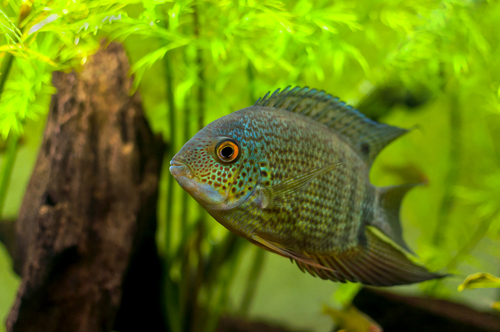
Comments (2)
My idea of the perfect tank is 3 silver dollar fish a pair of distichodus lusosso and 1 single male green severum cichlid
Hi. That sounds like a striking combination!